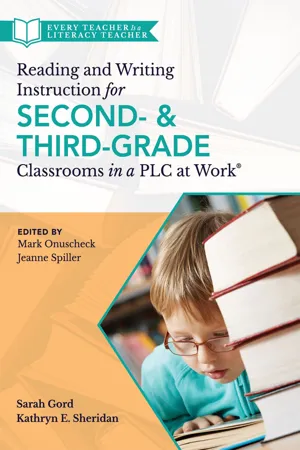
Reading and Writing Instruction for Second- and Third-Grade Classrooms in a PLC at Work®
- 312 pages
- English
- ePUB (mobile friendly)
- Available on iOS & Android
Reading and Writing Instruction for Second- and Third-Grade Classrooms in a PLC at Work®
About This Book
Fully prepare students to begin the pivotal transition from learning to read to reading to learn. Written for individual teachers and collaborative teams, this resource outlines how to craft instruction to ensure every learner masters literacy expectations in second and third grade. Readers will gain a wealth of strategies and practices for designing standards-aligned instruction, developing quality assessment, providing timely interventions, and more.
Use this resource to address specific literacy challenges found within the second- and third-grade band:
- Understand the role professional learning communities (PLCs) play in literacy development.
- Learn how teams of teachers can maximize their collective strengths to make profound impacts on student literacy and reading comprehension.
- Obtain instructional strategies and tools, such as the pre-unit protocol (PREP), for unpacking and clarifying literacy standards.
- Observe how to collaboratively score quality assessments as a team and conduct effective data inquiry and analysis.
- Study the powerful impact literacy has on student engagement and inclusivity in grades two and three.
Contents:
Introduction: Every Teacher Is a Literacy Teacher
Chapter 1: Establish Clarity About Student Learning Expectations
Chapter 2: Examine Assessment Options for Literacy
Chapter 3: Create a Learning Progression to Guide Instruction and Assessment
Chapter 4: Develop Collective Understanding of Learning Expectations
Chapter 5: Respond to Data to Ensure All Students Learn
Chapter 6: Differentiate Instruction With Gradual Release of Responsibility
Chapter 7: Plan High-Quality Literacy Instruction
Chapter 8: Select Appropriate Instructional Strategies
Chapter 9: Consider Equity in Literacy
Epilogue
Appendix A: List of Figures and Tables
Appendix B: Templates and Tools
Appendix C: Process for Prioritizing Standards
Appendix D: Essential Understandings and Guiding Questions
References and Resources
Index
Frequently asked questions
Information
Table of contents
- Cover
- Title Page
- Copyright
- Acknowledgments
- Table of Contents
- About the Series Editors
- About the Authors
- Introduction: Every Teacher Is a Literacy Teacher
- Chapter 1: Establish Clarity About Student Learning Expectations
- Chapter 2: Examine Assessment Options for Literacy
- Chapter 3: Create a Learning Progression to Guide Instruction and Assessment
- Chapter 4: Develop Collective Understanding of Mastery Expectations
- Chapter 5: Respond to Student Data to Ensure All Students Learn
- Chapter 6: Design Lessons Using the Gradual Release of Responsibility Instructional Framework
- Chapter 7: Plan High-Quality Literacy Instruction
- Chapter 8: Select Appropriate Instructional Strategies
- Chapter 9: Consider Equity in Literacy
- Epilogue
- Appendix A: PREP Template and Other Tools
- Appendix B: Process for Prioritizing Standards
- Appendix C: Depth of Knowledge Overview
- Appendix D: Essential Understandings and Guiding Questions
- Appendix E: List of Figures and Tables
- References and Resources
- Index